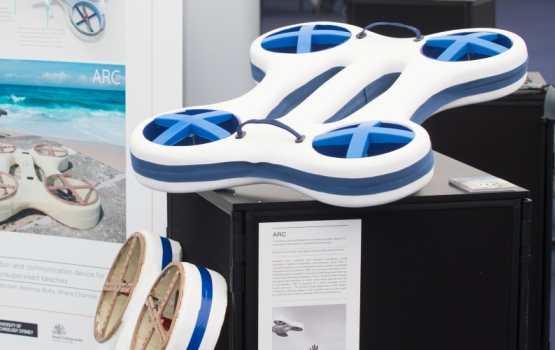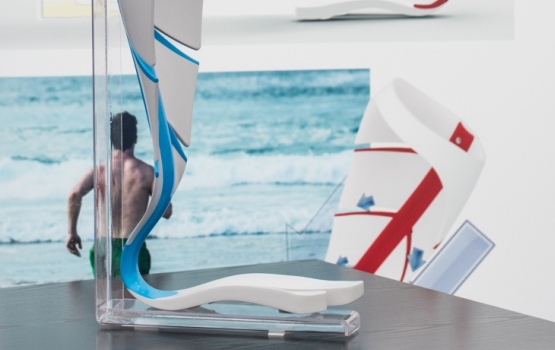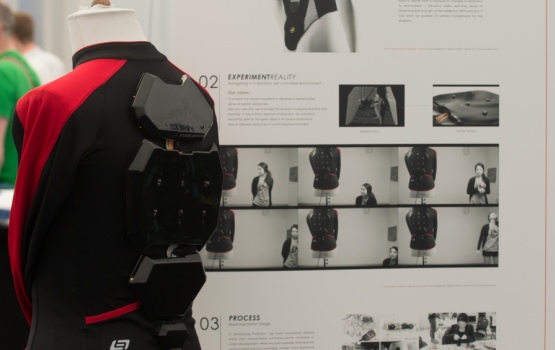

A remote control mini-helicopter for saving swimmers in distress is one of the devices on display at a new exhibition at Imperial.
The exhibition, which is being held in the Main Entrance of the College from 7-11 October, is part of a series of week-long events to celebrate the achievements of students taking part in the Rio Tinto Sports Innovation Challenge. The Challenge, now in its third year, involves undergraduates from across the Faculty of Engineering. As part of their studies, they develop technologies to potentially save lives and improve the performance of Paralympians and the wider community of people living with disabilities.
"The fantastic technologies on display are a testament to the imagination and skills of our students."
– Dr Dominic Southgate
Co-ordinator of the Rio Tinto Sports Innovation Challenge

The week-long event is also an opportunity to welcome the next cohort of students taking part in the Challenge, who will be developing projects over the coming 12 months. As part of this, elite athletes including Dan Greaves, four time discus Paralympic medallist, and sports industry experts will be on hand to provide insights for students into the types of technologies that could improve the lives of those living with disabilities.
The exhibition will showcase some of the best prototype devices developed by the student teams. As part of their studies in MSc in Innovation Design Engineering course, which is run jointly between Imperial and the Royal College of Art, the students visited Australia on a field trip and worked in collaboration with students from University Technology Sydney. The projects reflect the needs of people living in Australia’s unique environment.
One of the teams will display a prototype device called ARC that can fly out and save swimmers or surfers in distress in the ocean. Powerful surf currents and variable conditions make Australia’s beaches very hazardous. More than 50 per cent of drowning deaths occur on isolated beaches or after hours when lifeguards are not around.
ARC is a remote controlled mini-helicopter that has four rotating blades at each corner. The beauty of ARC is that it can be flown by anyone who is on the beach to those in distress in the water. The device has a buoyant chassis and can land near the distressed swimmer, providing a small flotation raft that the person can grab onto to keep alive while a rescue is being organised. On the beach, the operator of the mini-copter can also communicate with the swimmer via voice communication to keep them calm. A portal station, designed to house the mini-helicopter when not in use, would provide instructions about how to activate it in an emergency and as a preventative measure, remind visitors of volatile surf conditions along dangerous parts of the local coastline.
Another device on display is called Murr-ma, which is an Australian Aboriginal term that means “to wade through the water looking for something with your feet”. The device would enable leg amputees to swim more effectively in the water. Currently, prosthetics designed for people who have had their leg amputated below the knee are primarily designed for walking or running and perform badly in an aquatic setting. Murr-ma enables the wearer to make a smooth transition from running to swimming. It could enable people to partake in activities such as surf life saving, which is a popular Australian activity. The team believe that the carbon fibre prosthetic, which has additional fins protruding from the side, provides the wearer with enough thrust to even outperform able bodied athletes.
Dr Dominic Southgate, Co-ordinator of the Rio Tinto Sports Innovation Challenge from the Department of Bioengineering at Imperial, says: “The Challenge is designed to run until the end of 2016 - just in time for the Rio 2016 Paralympic Games. The ultimate aim of the Challenge is to have an innovation developed by our students for use during the Games. The fantastic technologies on display this week are a testament to the imagination and skills of our students. Who knows - one day, one of these technologies might be used to improve how Paralympians train and compete. This is also an opportunity to welcome the next cohort of students to the Challange. We look forward to seeing where their imagination takes them.”
Also during the week, undergraduates beginning the Challenge will take part in a “dragon’s den-esque” event where they will network with “dragons” or entrepreneurs. The idea is for students to team up with entrepreneurs and develop a business proposal over the following few months with the aim of creating a new technology for those living with disabilities. In spring in 2014, a winner will be chosen at a showcase event and awarded a prize to kick-start the project. The event has been organised in association with Imperial Innovations, which helps take research from institutions such as Imperial from the lab bench to the market place.
Article text (excluding photos or graphics) available under an Attribution-NonCommercial-ShareAlike Creative Commons license.
Photos and graphics subject to third party copyright used with permission or © Imperial College London.
Reporter
Colin Smith
Communications and Public Affairs

Contact details
Email: press.office@imperial.ac.uk
Show all stories by this author










